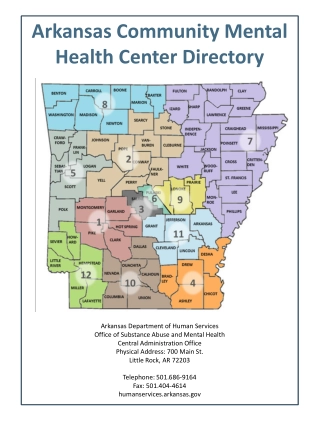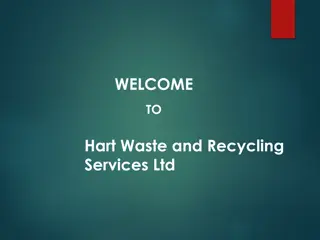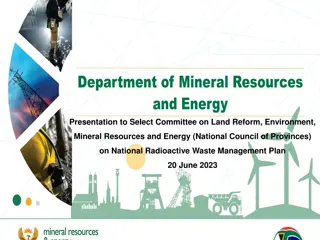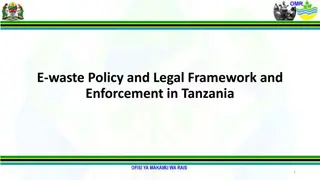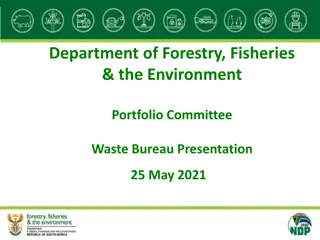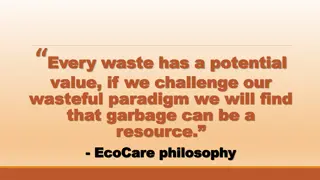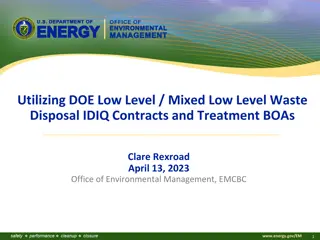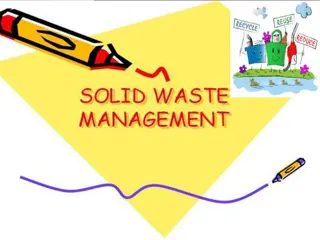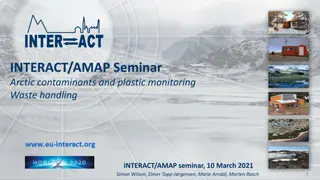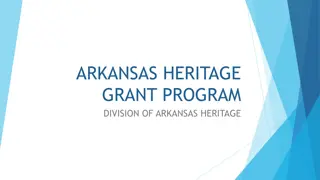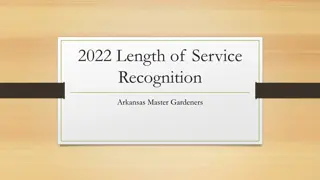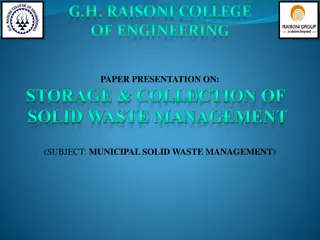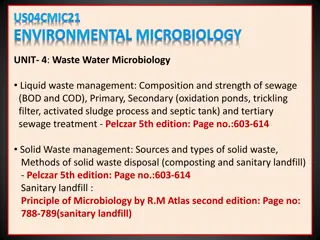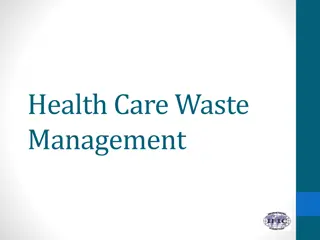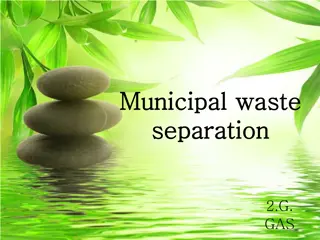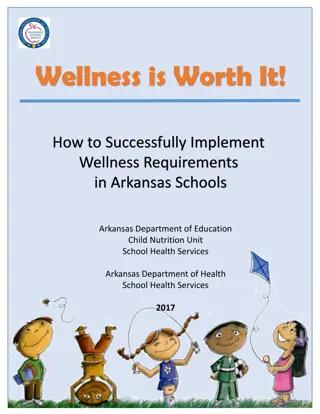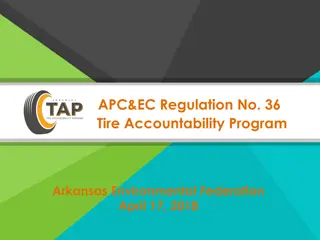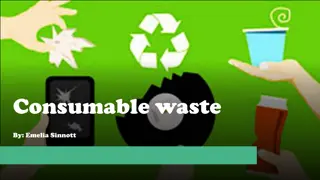Arkansas Environmental Federation Regulated Waste Seminar
Join the Arkansas Environmental Federation for a seminar on regulated waste management featuring Penny J. Wilson, Compliance Branch Manager at the Arkansas Department of Environmental Quality. Learn about the Generator Improvements Rule history, EPA comments, final rule publication, and more.
Download Presentation

Please find below an Image/Link to download the presentation.
The content on the website is provided AS IS for your information and personal use only. It may not be sold, licensed, or shared on other websites without obtaining consent from the author.If you encounter any issues during the download, it is possible that the publisher has removed the file from their server.
You are allowed to download the files provided on this website for personal or commercial use, subject to the condition that they are used lawfully. All files are the property of their respective owners.
The content on the website is provided AS IS for your information and personal use only. It may not be sold, licensed, or shared on other websites without obtaining consent from the author.
E N D
Presentation Transcript
Arkansas Environmental Federation Regulated Waste Seminar Penny J. Wilson Compliance Branch Manager Office of Land Resources Arkansas Department of Environmental Quality
History of the Rule Most of the generator rules were promulgated in the 1980s September 25, 2015: Proposed Rule was published Over 60 proposed changes
History of the Rule EPA received over 230 comments from: States Local governments Academic institutions Energy sector/utilities Industry and trade associations Waste management industry
History of the Rule November 28, 2016: Final Rule was published and is intended to Improve compliance and flexibility; Reorganize, consolidate, and explain requirements in greater detail; and Clarify and incorporate guidance, notices, and policies.
History of the Rule Several petitioners filed a statement of issues Challenging the condition for exemption found in 262.14, 262.15, 262.16, 262.17, 262.70, and subparts K and L of Part 262 Currently waiting on a settlement
Statement of Issues Conditions for Exemptions vs. Independent Requirements
Conditions for Exemptions Regulatory requirements that must be met for the generator to be exempt from the requirement to obtain a permit.
Independent Requirements These are not tied to any condition for an exemption to obtain a permit they are independent.
What Changed? VSQG has replaced CESQG VSQG can ship hazardous waste without a manifest to an LQG under the control of the same person Episodic generation
What Changed? Satellite Accumulation Areas (SAA): Now have their own part in the regulations Allow containers to remain temporarily open under limited circumstances Provides accumulation quantities for acute hazardous waste Must mark containers Hazardous Waste and with the hazards
What Changed? LQGs may request a waiver from the 50-foot requirement for ignitable or reactive waste Clarifies that SQGs may accumulate hazardous waste on drip pads and in containment buildings
What Changed? Allows the use of computer-based tools for personnel training Emergency planning and preparedness changes Contingency Plan quick reference guide Home addresses and phone numbers are no longer required include emergency number
What Changed? Closure: Requires LQGs to notify EPA or State when closing a facility or accumulation unit Use Site Id form to notify when closing the facility: 30 days prior and 90 days after
What Changed? New Recordkeeping Requirements: Episodic generation; VSQG waste consolidation; Tanks; Closure waste accumulation unit(s); 50-foot waiver; and Arrangements with local authorities.
New Reporting Requirements SQG re-notification; LQGs receiving waste from VSQGs; Episodic generation; Closure; and Contingency Plan quick reference guide.
DSWHere We Go Again! The latest version was published in January 2015 to resolve legal challenges to the 2008 rule. Then, guess what?
DSW The 2015 rulemaking was challenged in court! The challengers were Industry Petitioners and Environmental Petitioners.
Petitioners Issues Industry: Legitimacy factors and verified recycler exceeded EPA s authority; and Challenged EPA s treatment of spent catalysts and off-spec commercial chemical products.
Petitioners Issues Environmental: Verified recycler exclusion is too permissive; and EPA should have added containment and notification conditions to the 32 existing recycling exclusions/exemptions.
What Did The Court Say? July 2017: The U.S. Court of Appeals ruled on the petitions. Upheld some aspects of the rule and vacated others! But the court left the door open for a rehearing on one of the vacated components.
What Happened? The DC Circuit Court reviewed the petitions and revised its 2017 decision on March 6, 2018.
Whats Changing? Factor 4 of the legitimacy criteria has been vacated. This reinstates the criteria from the 2008 rule where Factor 4 must be considered it is no longer mandatory.
Whats Changing? The verified recycler exclusion in the 2015 rule is vacated. Except for the emergency preparedness provisions and the expanded containment requirement.
Whats Changing Instead of the verified recycler exclusion, the court reinstated the transfer-based exclusion from the 2008 rule. Allows a generator to send material to a reclaimer that does not have a RCRA permit IF the generator has made reasonable efforts to ensure the hazardous secondary material will be legitimately reclaimed.
Whats Changing? The reinstated transfer-based exclusion will be available for spent catalyst that will be reclaimed otherwise it would have to be managed as a listed hazardous waste.
What Happens Now? EPA will issue a Direct Final Rule to address the Court s decisions.
Next Steps ADEQ will: Initiate rulemaking to adopt the Generator Improvements Rule Initiate rulemaking to adopt the Revised Definition of Solid Waste
Next Steps ADEQ will offer training on both the new Generator Improvements Rule and the Revised Definition of Solid Waste stay tuned!
Questions? Contacts: Penny J. Wilson 501-682-0868 wilson@adeq.state.ar.us Ann Blake 501-682-0827 blake@adeq.state.ar.us


